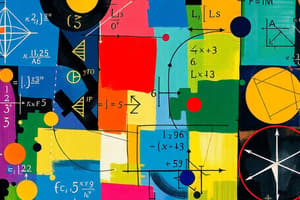Podcast
Questions and Answers
What is the correct formula for calculating the area of a circle?
What is the correct formula for calculating the area of a circle?
- $\pi r^2$ (correct)
- $2\pi r$
- $\frac{1}{2}bh$
- $\pi d$
What type of triangle has all sides of equal length?
What type of triangle has all sides of equal length?
- Scalene
- Isosceles
- Equilateral (correct)
- Acute
What does the Law of Sines state about the sides and angles of a triangle?
What does the Law of Sines state about the sides and angles of a triangle?
- $a/sin(A) = b/sin(B) = c/sin(C)$ (correct)
- $sin(A) = sin(B)$
- $c = a + b$
- $a^2 = b^2 + c^2$
What is the result of applying the Pythagorean identity sin²(θ) + cos²(θ) = 1?
What is the result of applying the Pythagorean identity sin²(θ) + cos²(θ) = 1?
Which of the following is an example of a quadratic equation?
Which of the following is an example of a quadratic equation?
What is the definition of a derivative in calculus?
What is the definition of a derivative in calculus?
In calculus, what does the Fundamental Theorem of Calculus connect?
In calculus, what does the Fundamental Theorem of Calculus connect?
What does a linear function typically represent in algebra?
What does a linear function typically represent in algebra?
Flashcards are hidden until you start studying
Study Notes
Geometry
- Definition: Study of shapes, sizes, and properties of space.
- Key Concepts:
- Points, Lines, and Angles: Fundamental building blocks of geometry.
- Triangles: Types include isosceles, equilateral, and scalene; properties like the Pythagorean theorem.
- Circles: Terms include radius, diameter, circumference, and area; central angles and inscribed angles.
- Polygons: Characteristics of regular and irregular polygons; formulas for perimeter and area.
- Solid Geometry: 3D shapes like cubes, spheres, and cylinders; volume and surface area calculations.
Trigonometry
- Definition: Study of relationships between angles and sides of triangles.
- Key Concepts:
- Trigonometric Ratios: Sine (sin), Cosine (cos), Tangent (tan); relationships in right triangles.
- Unit Circle: Defines trigonometric functions for all angles; key angles (0°, 30°, 45°, 60°, 90°).
- Pythagorean Identity: sin²(θ) + cos²(θ) = 1.
- Laws:
- Law of Sines: a/sin(A) = b/sin(B) = c/sin(C).
- Law of Cosines: c² = a² + b² - 2ab*cos(C).
- Applications: Used in physics, engineering, and navigation.
Algebra
- Definition: Branch of mathematics dealing with symbols and the rules for manipulating those symbols.
- Key Concepts:
- Variables and Expressions: Understanding coefficients, constants, and algebraic expressions.
- Equations: Solving linear equations and inequalities; quadratic equations using the quadratic formula.
- Functions: Definition, notation, and types (linear, quadratic, polynomial, exponential).
- Graphing: Coordinate planes, plotting points, understanding slopes and intercepts.
- Factoring: Techniques such as grouping and using the difference of squares.
Calculus
- Definition: Study of change and motion; divided into differential and integral calculus.
- Key Concepts:
- Limits: Fundamental concept for defining derivatives and integrals; approaches to a value.
- Derivatives: Measure of instantaneous rate of change; rules (product, quotient, chain rule).
- Integrals: Represents area under curves; definite vs. indefinite integrals; Fundamental Theorem of Calculus.
- Applications: Used in physics, engineering, economics; optimization problems and area calculations.
Geometry
- Study of shapes, sizes, and properties of space.
- Points, lines, and angles constitute the fundamental building blocks of geometry.
- Types of triangles:
- Isosceles (two sides equal)
- Equilateral (all sides equal)
- Scalene (no sides equal)
- Pythagorean theorem applies to right triangles.
- Circles defined by key terms:
- Radius (distance from center to perimeter)
- Diameter (distance across the circle through center)
- Circumference (perimeter of the circle)
- Area calculation uses πr².
- Polygons classified as regular (equal sides and angles) or irregular (unequal).
- Perimeter and area formulas differ among polygon types.
- Solid geometry includes 3D shapes like cubes (6 faces), spheres (all points equidistant), and cylinders (two bases, curved surface).
- Volume and surface area calculations are essential for solids.
Trigonometry
- Focuses on relationships between angles and sides of triangles.
- Trigonometric ratios essential for right triangles:
- Sine (sin), Cosine (cos), Tangent (tan).
- Unit Circle provides a comprehensive view of trigonometric functions for all angles.
- Key angles to remember: 0°, 30°, 45°, 60°, 90°.
- Pythagorean Identity establishes a fundamental relationship: sin²(θ) + cos²(θ) = 1.
- Law of Sines and Law of Cosines assist in solving triangle problems.
- Applications extend to physics, engineering, and navigation, aiding in various calculations and modelings.
Algebra
- Involves symbols and rules for manipulation.
- Understanding variables (letters representing numbers), coefficients, constants, and expressions is key.
- Linear equations and inequalities can be solved using algebraic methods.
- Quadratic equations require the quadratic formula for solutions.
- Functions defined by their outputs based on inputs; types include linear, quadratic, polynomial, and exponential.
- Graphing uses coordinate planes for plotting points. Slopes indicate steepness while intercepts show where the line crosses axes.
- Factoring techniques include grouping and the difference of squares, essential for simplifying expressions.
Calculus
- Explores change and motion; divided into differential and integral calculus.
- Limits provide foundational understanding for derivatives and integrals, defining behavior as values approach a point.
- Derivatives quantify instantaneous rates of change; rules for finding derivatives include product, quotient, and chain rules.
- Integrals represent the area beneath curves, differentiated into definite (specific bounds) and indefinite (general form) integrals.
- Fundamental Theorem of Calculus links derivatives and integrals, showcasing their interrelation.
- Applications span various fields such as physics, engineering, and economics, commonly used for optimization and area calculations.
Studying That Suits You
Use AI to generate personalized quizzes and flashcards to suit your learning preferences.




